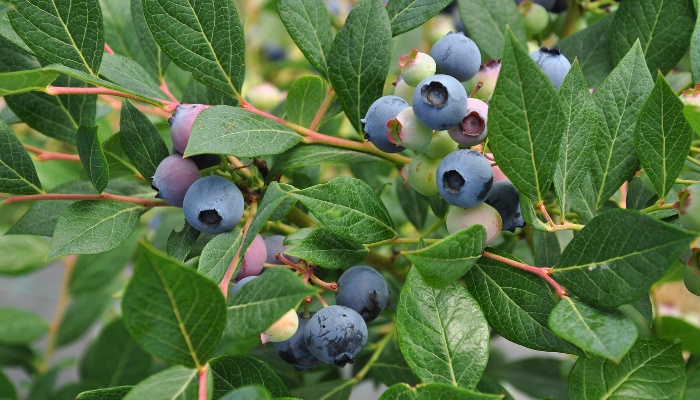Avoid planting high-nitrogen plants such as legumes, alkaline-loving plants like clematis, or invasive species such as mint near blueberries.
Opt for acid-loving, low-nitrogen plants with similar sunlight and water needs to ensure a harmonious environment for optimal blueberry growth.
Companion planting, the strategic placement of plants to enhance growth and repel pests, can play a pivotal role in the overall health and productivity of blueberry plants.
However, some plants pair better with blueberries than others do.
Table of Contents
Factors Affecting Blueberry Growth
Blueberries’ growth is influenced by several factors that savvy gardeners must consider.
Let’s explore the key elements affecting their development so you’ll have a better understanding of which plants will and will not thrive in the same vicinity.
Soil Acidity Requirements for Blueberries
Blueberries thrive in acidic soil conditions with an ideal pH range between 4.5 and 5.5. This acidity is crucial for nutrient absorption and overall plant health.
Deviations from this range can adversely affect blueberry growth.
When selecting companion plants, it’s imperative to consider their impact on soil pH.
Avoiding plants that prefer alkaline soil ensures the maintenance of the acidic environment that blueberries favor.
Shading Preferences and Sunlight Requirements
Optimal sunlight exposure is essential for blueberries as they generally require full sunlight for optimal growth and fruit production.
Companion plants that cast dense shade can hinder the sunlight exposure that blueberry bushes need.
Understanding the sunlight requirements of both blueberries and potential companion plants is key to preventing shading issues that may compromise the health of your blueberry crop.
Water and Nutrient Needs of Blueberry Plants
Blueberries have specific water and nutrient requirements.
Selecting companion plants that share similar needs ensures a harmonious environment that benefits all crops in your garden.
Overly competitive plants that absorb excessive water or nutrients may negatively impact blueberry growth.
Choosing plants with comparable water and nutrient preferences is essential for creating an ecosystem where all plants thrive.
Plants To Avoid Near Blueberries
While companion planting offers numerous benefits, not all plants are suitable neighbors for blueberries.
Here are the plants to avoid and the reasons behind these choices.
High Nitrogen Plants
While nitrogen is an essential nutrient for plants, an excess of it can be detrimental to blueberries.
High nitrogen levels promote vigorous foliage growth at the expense of fruit production.
To maintain a balanced nutrient environment, avoid planting nitrogen-rich companions such as legumes (peas and beans) or plants treated with nitrogen-heavy fertilizers near blueberries.
Plants With Different Soil pH Preferences
Blueberries’ preference for acidic soil clashes with plants that thrive in alkaline conditions.
Avoid companion plants with conflicting soil pH requirements, such as lavender or clematis, to prevent soil pH imbalances that can affect the nutrient availability for blueberries.
Aggressive and Invasive Plants
Some plants exhibit aggressive growth habits, quickly spreading and competing for resources.
Invasive species can outcompete blueberries for sunlight, water, and nutrients, hindering their growth.
Plants like mint or bamboo, known for their invasive nature, should be kept at a safe distance from blueberries to prevent unwanted competition.
Plants That Attract Pests or Diseases
Certain plants can attract pests or diseases that may harm blueberries.
For instance, planting crops like tomatoes, which are susceptible to similar diseases, in close proximity can create an environment conducive to the spread of pathogens.
Be cautious about selecting plants that may increase the risk of pests or diseases affecting your blueberry bushes.
Beneficial Companion Plants for Blueberries
Companion planting isn’t just about avoiding the wrong plants; it’s also about selecting the right ones.
Below, you’ll find beneficial companions that contribute positively to blueberry growth.
Low-Nitrogen, Acid-Loving Plants
To create an environment that fosters the well-being of blueberries, consider companion plants that are low in nitrogen and thrive in acidic soil conditions.
Some excellent choices include:
- Azaleas: These ornamental shrubs not only share the acidic soil preference but also provide a burst of color to your garden.
- Rhododendrons: Similar to azaleas, rhododendrons are acid-loving plants that complement blueberries aesthetically while contributing to soil health.
- Heathers: These low-growing, evergreen plants not only enhance soil acidity but also provide ground cover, helping to conserve moisture and suppress weeds.
Plants With Similar Sunlight and Water Requirements
Harmony in sunlight and water needs is vital for successful companion planting.
Select plants that thrive under similar conditions to blueberries, promoting an ecosystem that benefits all involved. Some compatible choices include:
- Lingonberries: Sharing similar growth requirements with blueberries, lingonberries are a great companion that complements the visual appeal of your garden.
- Highbush Cranberries: These shrubs prefer similar acidic soil conditions and contribute to the overall diversity of your garden.

